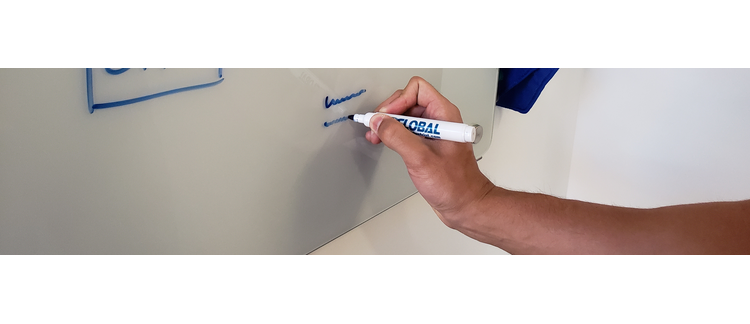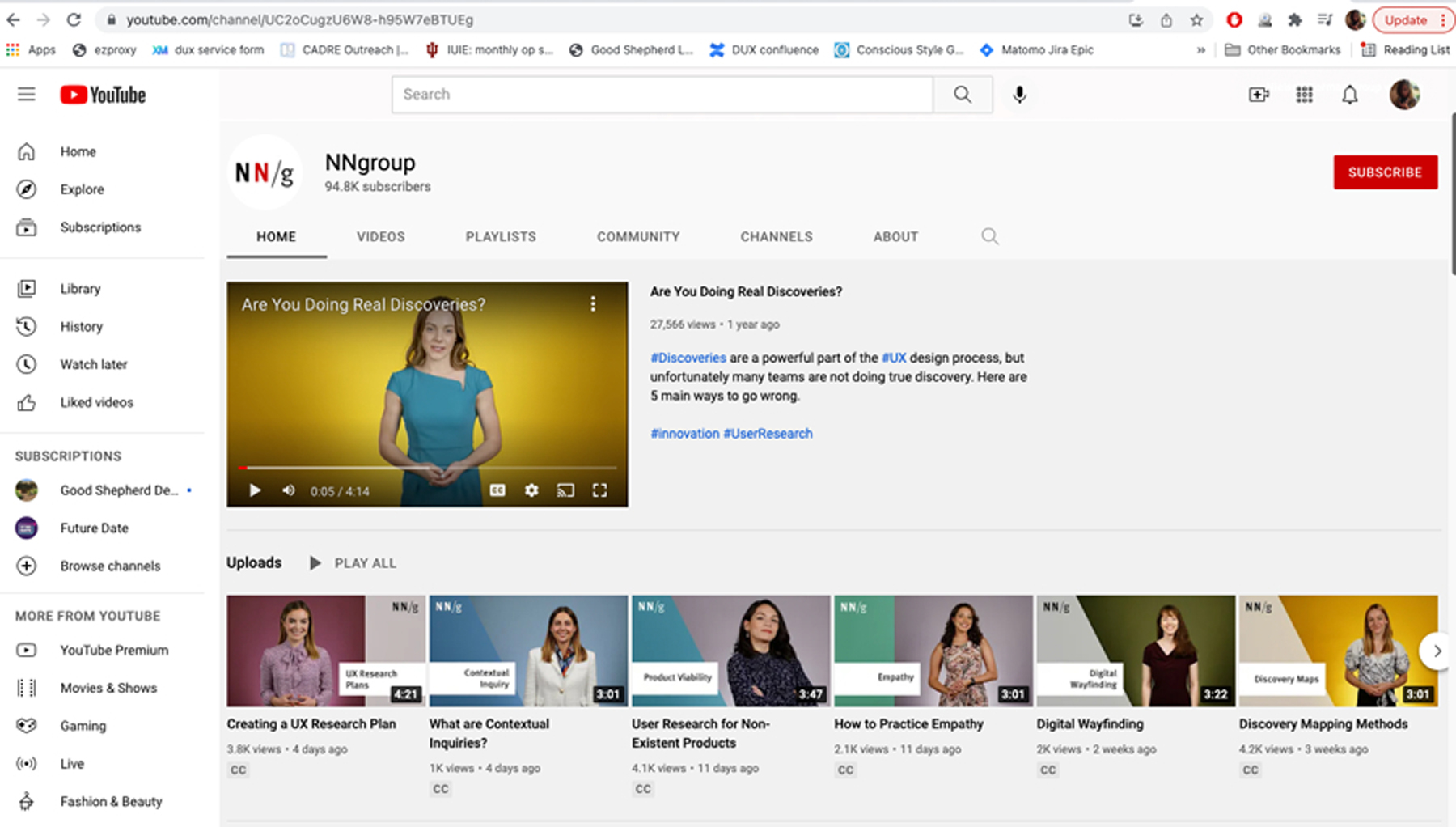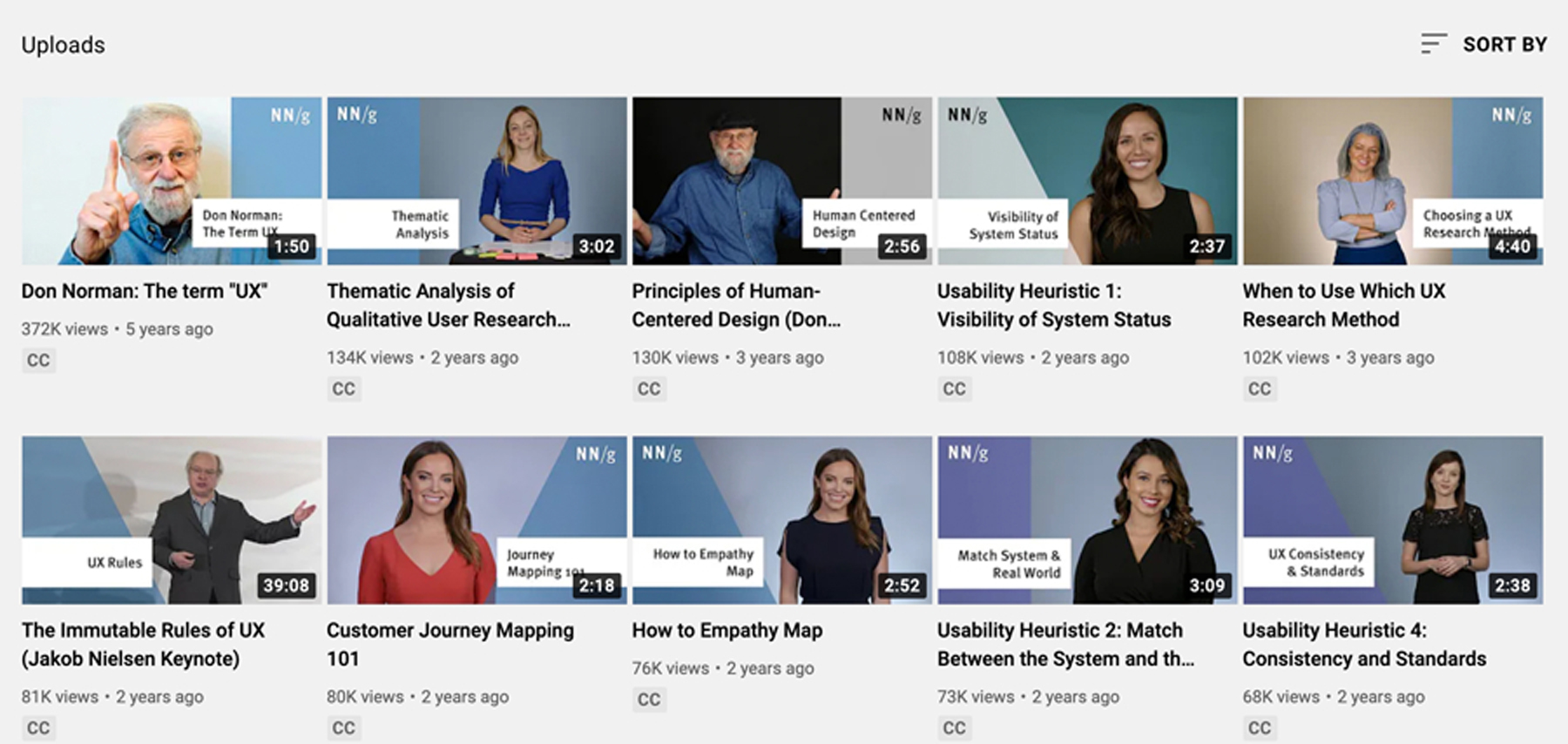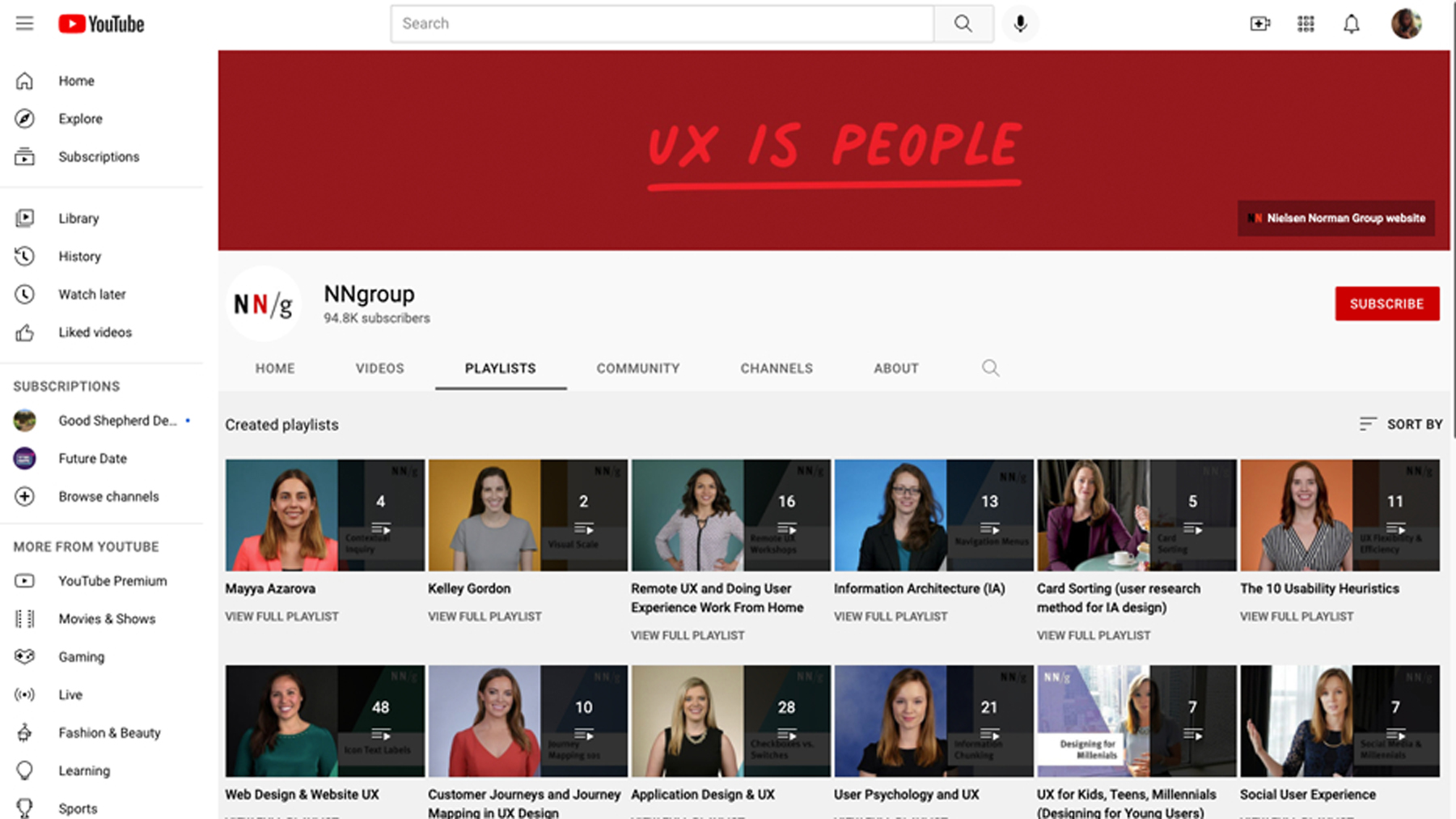A Caveat
When training new student workers in my department, I often assign Nielsen Norman Group (NN/g) articles (https://www.nngroup.com/articles/) or videos (https://www.youtube.com/c/NNgroup/) to introduce new concepts or methods. The content is high-quality, easy to understand, and freely available online. And if this is a student in human-computer interaction, user experience (UX), or librarianship, I preface the assignment with context about NN/g and its founders’ importance in the UX field.
But with my most recent student worker, I provided additional context. A caveat. My student employee, a Black woman and information science major, would not see anyone who looked like her in the NN/g videos I assigned. I explained my uneasiness with the homogeneity of visuals in NN/g videos, as exemplified in Figure 1. Young, white or white-presenting, normatively attractive women delivered a majority of the content. These women were experts in their fields, I explained to the student, not hired actors, but their uniformity was impossible to ignore, and it undercut their expertise as UX professionals. As a young, white woman, I also feel professionally undermined and suspect for gravitating toward video content of people who only look like me and calling it authoritative.
I don’t want to rely on NN/g videos anymore in my instruction and work. The sexism and whitewashing sets a bad example to my colleagues and students. This content contributes to the harmful representation of UX as a pink-collar field and compounds librarianship’s own pink-collar culture, a century-old manipulation of librarians as “tender technicians” (Garrison, 1972; Sloniowski, 2016) done up in the aesthetics of YouTube beauty vloggers.
A Selling Sunset Reference
Explaining to my student worker my uneasiness about NN/g’s choice to predominantly feature young, white or white-presenting, normatively good-looking women, I referenced a related confusion I have about the popular Netflix reality show Selling Sunset. Are the glamorous, young women real estate agents featured in that show competent real estate agents, or do their employers—two white men—use them to drive property sales and open-house foot traffic? Their uniform, normative good looks undercut their skills, and Selling Sunset rarely gives airtime to any of the women agents demonstrating professional expertise. Instead, they give tours at open houses and rattle off information that the wealthy men who are prospective buyers could glean from a handout. These women real estate agents appear interchangeable and therefore disposable.
By the Numbers
On the NN/g YouTube home page, users can sort videos by popularity. The top ten videos are presented by NN/g’s founders, Donald Norman and Jakob Nielsen, and five different young, attractive women. Four of the five are white or white-presenting. The screenshot in Figure 2 shows the ten most popular videos presented to me on YouTube in January 2022. The “reply girl” trend (“Reply Girl,” n.d.) and Bishop’s (2018) criticism of YouTube algorithms provides precedent for NN/g’s possible tactic; attractive women, particularly when they are in the thumbnail of a video, drive traffic. The soft, pastel-hued backdrops, hyper-lit front-facing video format combined with well-coiffed, impeccably dressed women in NN/g videos bears striking resemblance to popular beauty vlogger channels. NN/g may not consciously choreograph its content to match the widespread beauty content on YouTube, but if it is interested in maximizing clicks to its content on this platform, then research shows these aesthetics will drive traffic. Bishop (2018) found that the YouTube algorithm has gender bias and gives preference to content that features attractive, sexualized women in traditional roles.
On the NN/g YouTube channel, there are playlists (https://www.youtube.com/c/NNgroup/playlists) named for the NN/g employee featured in the videos, as in Figure 3. Of the employees with their own playlists, Sarah Gibbons (38 videos), Kate Moran (37 videos), Alita Joyce (30 videos), and Kara Pernice (27 videos), have the most videos under their name besides Jakob Nielsen, who has 84 videos in the playlist bearing his name. All four of these individuals are attractive young women, and three of them are white or white-presenting. Scrolling through the NN/g playlists, there is only one playlist thumbnail that includes an image of what appears to be a woman of color, for the video “Behavioral Economics & UX (user experience) Design,” highlighted with a red box in Figure 4. However, clicking on the playlist leads to videos that do not include that particular woman or video.
Signaling Expertise or Objectification
NN/g videos include title cards at the beginning with the name and title of the presenter, for example, “Sarah Gibbons, Chief Designer.” This information implies the person in the video is imparting their expertise, not just narrating a script, and understanding their qualifications and title is a meaningful piece of information.
However, the scripts are generic and primarily refer to the collective “we” or “us,” for example, “we know all journey maps look different” in the video “Customer Journey Mapping” (https://www.youtube.com/watch?v=2W13ext26kQ&ab_channel=NNgroup, :20); the expertise briefly noted in the title card isn’t referenced through the narration or even mention of that person’s specific professional experiences at NN/g. This, combined with the homogeneity of appearance of women in these videos, undercuts each employee’s expertise and humanity. I have met some of these women: one in graduate school, two others during live classes I took through NN/g. I have heard their compelling stories as experts and researchers in this field. Omitting their individual knowledge in these videos is a frustrating creative decision on the part of NN/g because it makes its female employees appear lacking in skill and interchangeable.
Why It Matters
Although NN/g doesn’t specifically provide content about library UX, it is a widely used, authoritative resource in our field. The founders of NN/g are also considered founders of what we think of as “user experience.” It is our responsibility as UX practitioners, or librarians who use UX methods, to critically question the tools and resources we use, especially as Seale et al. (2022) conclude that the foundational concepts of UX “reproduce the library as a space where ‘belonging is constructed around whiteness’ and being able-bodied” (p. 7). What does the makeup of NN/g’s video presenters tell us about UX as a field? That it values and gives preference to information from and by attractive, anonymous white women and the white men who employ them.
This stark lack of representation in NN/g videos compounds librarianship’s own whiteness and representation problems, which Kendrick and Damasco (2019) called “chronically racially hegemonic and feminized (p. 177).” NN/g’s aesthetics feminize UX work in a similar fashion. The optics of using predominantly young, attractive, white or white-presenting women in video content, combined with an emphasis on customer service, empathy toward users, and qualitative data collection methods that highlight skills like listening and silence, relegate UX to a “pink-collar” profession, contrasting with the cis white male “tech bro” persona mapped onto developer or programmer labor (Constanza-Chock, 2020). NN/g’s feminization of UX and its overwhelming whiteness exclude others from feeling welcome in the field and minimize the expertise and humanity of its employees featured in video content. For librarians who use UX methods, this compounds the undervaluing of librarian research and labors (Sloniowski, 2016).
Alternative Resources
To reduce dependency on NN/g video content in your UX practice, here are recommendations for other resources. A few of the groups featured below are explicitly invested in diversifying UX, design, and related fields. This is a starting point, not a definitive list. Most of these resources are not outright replacements for the NN/g video content I’ve critiqued because of differing ideology; liberative and justice-oriented resources often prioritize specificity and context, in contrast with the universalizing, generic style that makes NN/g content useful, especially to UX beginners.
The United States and United Kingdom’s governments host valuable UX tools and guidelines in the English language. For the US, see both the digital.gov (https://digital.gov/) site and the 18F Agency site (https://18f.gsa.gov/guides/). For the UK, see Government Design Principles (https://www.gov.uk/guidance/government-design-principles). Neither have invested in video content, but there is a similar universalizing style with less specific examples or case studies.
The UX Cookbook (https://theuxcookbook.com/) is maintained by the UX team at the University of Arizona Libraries. Similar to NN/g, this content is geared toward an introductory audience. It is easy to navigate and won’t overwhelm beginners. Although there isn’t video content, photos of live testing feature a diverse array of people, not stock photography.
The open access e-book Design Justice (https://design-justice.pubpub.org), by Sasha Constanza-Chock, bills itself in the overview as going “beyond recent calls for good, user-centered design, and employment diversity in the technology and design professions; it connects design to larger struggles for collective liberation and ecological survival.” The chapter “Nothing about Us without Us” is a great entry point or standalone reading.
The Indigenous Participatory Design Toolkit (https://www.lib.montana.edu/indigenous-design-toolkit/) is an excellent suite of activities for design sprints or similar gatherings with users or colleagues.
NN/g also hosts a vast network of conferences and classes. I have taken some of these courses and considered them a worthwhile use of my time. However, when I have future professional development funding, I will consider supporting a consultation/training service like Build With (https://www.buildwith.org/hire-us ).
Do you know of more resources you think would work well in this list? Reach out (https://jacipaigewilkinson.wordpress.com/contact/) or sound off on Twitter (@jp_librarian and @WeaveUX).
References
Bishop, S. (2018). “Anxiety, panic and self-optimization: Inequalities and the YouTube algorithm.” Convergence 24(1), 69–84. https://doi.org/10.1177/1354856517736978https://doi.org/10.1177/1354856517736978
Costanza-Chock, S. (2020). Design justice: Community-led practices to build the worlds we need. MIT Press. https://design-justice.pubpub.orghttps://design-justice.pubpub.org
Garrison, D. (1972). The tender technicians: The feminization of public librarianship, 1876–1905. Journal of Social History, 6(2), 131–159.
Kendrick, K.D. & Damasco, I.T. (2019). “Low morale in ethnic and racial minority academic librarians: An experiential study.” Library Trends, 68(2), 174–212. http://doi.org/10.1353/lib.2019.0036http://doi.org/10.1353/lib.2019.0036
Reply girl. (n.d.). Wikipedia. Retrieved January 22, 2022, from https://en.wikipedia.org/wiki/Reply_girlhttps://en.wikipedia.org/wiki/Reply_girl
Seale, M., Hicks, A., & Nicholson, K. P. (2022). Toward a critical turn in library UX. College & Research Libraries, 83(1), 6–24. https://doi.org/10.5860/crl.83.1.6https://doi.org/10.5860/crl.83.1.6
Sloniowski, L. (2016). “Affective labor, resistance, and the academic librarian.” Library Trends 64(4), 645–666. https://doi.org/10.1353/lib.2016.0013https://doi.org/10.1353/lib.2016.0013




